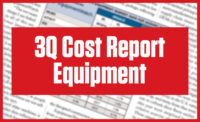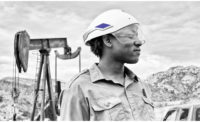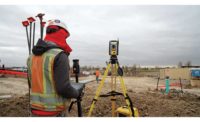At the start of 2020, construction technology was a hot market. Venture capital was pouring in as tech investors saw potential for growth. Industry firms that had already made investments in technology were seeing real gains from their efforts. When the COVID-19 pandemic rattled the construction industry this spring, technology providers dropped what they were doing to refocus on practical solutions to keep projects going in a frenetic triage. Now that the initial pandemic shock has passed and a new, unusual rhythm for construction has settled in, what happened to the momentum for broader technology adoption?
Construction tech’s focus on solving practical problems has lent itself well as a tool during the pandemic, according to Jit Kee Chin, chief data and innovation officer at Boston-based general contractor Suffolk. “We view the current situation as a challenge, a period to get over,” she says. “Typically after these periods of recession or slowdown, innovation tends to speed up.”
In the cyclical world of construction’s ups and downs, the pandemic interrupted what was considered a fairly healthy boom era. As a result, pullbacks in tech investment may not be as severe as in the past. “Talking to our portfolio companies and VCs, this [construction technology wave] will not stall, but it may slow,” says Chin. “The needs are still there, and will be there when the economy turns again. Now is good time to put our heads down and build a product for when demand returns.”
Industry Tech Responds
Before there can be a recovery, firms will have to adjust to new realities and limitations. And for some, previous investments in digitizing work flows and remote work plans are paying off.
“For us, we have seen a lot of the changes in response to the pandemic as an acceleration of things that were already in motion,” says Tom Wilcock, Arup’s Americas design leader. Firms that had invested in cloud computing and virtualization of their work environments saw a smoother shift to remote working, but maintaining business continuity has been only part of the problem. “The mechanics of working at home were not a huge challenge for us,” says Wilcock. “The bigger challenge was that collaboration and creativity are at the center of what we do … how do we recreate that creative spirit when we’re not all in the same space?”
The first tech innovations to emerge as COVID-19 upended ordinary life focused on safety. With social distancing requirements mandated on jobsites, Triax Technologies adapted its wearable worker-safety monitoring sensor to work as a social distancing alarm (ENR.com 4/22). Machine learning video-analysis vendor Smartvid.io reconfigured its software to track when workers bunched up and to identify bottlenecks on site (ENR.com 4/3). “We definitely saw things deployed that were not originally envisaged for the specific challenges of COVID-19,” says Wilcock.
“Now is a good time to put our heads down and build a product for when demand returns.”
– Jit Kee Chin, Chief Innovation Officer, Suffolk
Many general contractors’ programming teams quickly whipped up health tracking apps to meet new COVID-19 screening requirements on jobsites. “We had an entrepreneurial employee develop a health pre-screening app which we have now rolled out to almost all our jobsites,” says Henning Roedel, DPR’s West Coast innovation leader. Like many firms, DPR had to adjust to the realities of remote work. “We’ve also focused a lot on enabling project teams to work remotely,” he adds. “We’re doing virtual site inspections on a cellphone, all the way up to using a Hololens and augmented reality to follow along on site walks.” Roedel says these remote inspections have worked so well that project owners are beginning to embrace them as a way to safely walk the site during the pandemic.
At Arup, Wilcock says an internal call for ideas yielded some useful pitches from unexpected sectors. With in-person meetings now replaced by seemingly endless video conferences, Arup acoustical engineers developed a 3D audio plug-in for the company’s video conferences to improve sound quality. “Many of us experience ongoing fatigue from large amounts of time spent in the [video conference] medium. A key contributor to this issue is the low-quality, monophonic ‘in-your-head’ audio that most video conferencing applications employ to optimize bandwidth requirements,” explains Terence Caulkins, an acoustic, audiovisual and experience design associate at Arup. “To address this, we have developed an immersive environment that can be used to add 3D audio to video conferencing and allows users to interact with each other in a more embodied way.”
Looking beyond its immediate needs, Arup is also examining how its design practice might aid in dealing with the pandemic’s effects. “We knew that people would want to return to public spaces and work spaces eventually,” says Wilcock. Arup had developed its MassMotion tool for modeling indoor foot traffic in offices, airports and other similar large spaces. The tool got a fresh look during the COVID-19 response. “We had our MassMotion tool for navigating through space, but it didn’t have technological ability to accommodate social distancing,” says Wilcock. The team reconfigured the tool to model proper social distancing rules, and has already seen it in use by building owners trying to meet COVID-19 safety requirements.
New Collaborations and Virtual Incubators
Contractors and other industry firms have also been sharing notes on their COVID-19 response. While DPR’s innovation team focuses on internal improvements, the company has also teamed up with other firms to collectively evaluate new COVID-19-related safety tech. The Next Coalition is a new initiative between DPR, Black & Veatch, Haskell, McCarthy Building Cos., Swinerton and Truebeck Construction. Comprising firms with a history of investing in new technology, the Next Coalition aims to sift through ideas for keeping projects running safely during the pandemic.
“We saw a few other GCs in the same situation as us, and that formed the basis of the Next Coalition,” DPR’s Roedel says. “We realized we are all strapped for time and can’t look at all solutions coming in there, so if we can divide and conquer the vetting process, it will be beneficial to everyone.”
The Next Coalition is currently open for proposals to improve safety in construction during the COVID-19 pandemic, with member companies committing to share any workable ideas that come in. “These innovation leaders got together and realized there is a common need for all of this,” says Kaushal Diwan, DPR’s national director of innovation. “Why not just combine forces and create a funnel for these ideas? That way we can all compare notes, and startups can make one phone call instead of ten.”
“Innovation should not just be equated with technology—software and hardware. It should be about solving the problems people face.”
– Rick Khan, Sr. Dir. of Innovation, Mortenson
Suffolk had long been planning to launch its BOOST construction tech incubator this year. As a collaboration between its investment arm, Suffolk Tech; the MIT Center for Real Estate; and investors Bain Capital Ventures, Romulus Capital and EquipmentShare, Suffolk’s BOOST was planned as an intensive four-week program where newer construction tech companies could dive into the industry. The idea was to test out new products on real jobsites and connect young tech companies with investors and users. The program will be going fully virtual for its inaugural class, but Suffolk’s Chin doesn’t see that as a major obstacle to cultivating emerging technologies.
“Now is actually not a bad time to explore these ideas,” she says. “We have the operational test bed and resources to do this.” The companies will pitch their ideas, with a focus on tech products that are either market ready or near market ready. “There is no dedicated program where tech company founders can go to get into this industry,” says Raja Ghawi, investment associate at Suffolk Tech. “We are set up to show them how to hack growth and set up a company that will serve this industry.”
“This is a rare opportunity to be focused on new tech for the construction industry,” says Steve Weikal, head of industry relations at MIT’s Center for Real Estate, who will also be advising companies in the BOOST incubator. “So much of this kind of coaching is face-to-face; you want to be part of that experience,” he says. “But to do this virtually: How do you design that? So far Suffolk has done a good job of saying, ‘Here is the desired outcome, we are in a virtual world now, we will make this work.’ ”
Weikal expects that a broader selection of companies will apply since travel is now not required, and he says that construction and real estate venture capitalists are still very eager to invest. “There is a heck of a lot of dry powder in the [construction tech] investment world. The industry is realizing this transformation is going to happen one way or not,” he adds. Suffolk BOOST is currently open for applications through Oct. 16, with the four-week incubator to begin later that month.
While pilot projects for construction tech may have slowed, the level of interest hasn’t abated, says Burcin Kaplanoglu, executive officer and innovation director at Oracle. “We’ve actually seen an acceleration of technology adoption and digitization during this time. There is a lot more attention.” The Oracle Industries Innovation Lab in Deerfield, Ill., had been undergoing an expansion as a test bed for new construction tech. That work is still ongoing, and even with the limits on travel and gatherings, the Lab is being used to test remote monitoring and sensor technology.
“With the pandemic, we’re getting to the stuff that’s more immediately valuable to the user at this time,” says Kaplanoglu. “These were technologies that were thought of by users as neat, interesting tools. But now we’re in a situation where we need them. ‘Nice-to-have’ has become ‘must-have,’ ” he says.
And the real digital transformation may be more systemic, says Josh Johnson, engineering construction and building materials expert at McKinsey & Co. “It’s easy to look at solutions from a project-to-project perspective … but to transform these enterprises, they’ll have to be willing to make longer-term investments.”
Some firms are now refocusing on improving their own internal processes. “There is too much emerging tech that needs the contractors to validate it,” says Rick Khan, senior director of innovation at Mortenson Construction. “We’ve cut that out for now; we think this is not the time to do that.” Khan’s team is focusing instead on operational improvements to push for greater digitization of the firm’s back-office processes.
Despite the pullback, Mortenson is continuing its work with Built Robotics’ autonomous earthmoving equipment. Khan suspects that driverless machines may soon be even more in demand, as skilled operators find it impractical to travel to remote wind and solar energy installations during an ongoing pandemic.
“Innovation should not just be equated with technology—software and hardware,” he says. “It should be about solving the problems people face.” Even if revenues shrink into 2021, Khan sees innovation as a way out of the woods for industry firms reeling from the pandemic’s effects. “Our investments pivoted from small incremental ones to company-wide investments, and that really helped get rid of the noise,” he adds.
Still, seeing the widespread embrace of remote work for employees and remote monitoring of jobsites, Oracle’s Kaplanoglu senses a change in the air. “People in this industry are not pulling back from using technology right now; it’s quite the opposite,” he says. “It’s going to be a different industry when this is over.”












Post a comment to this article
Report Abusive Comment